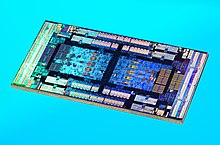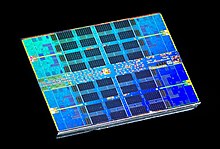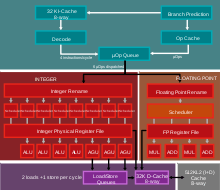Zen 2
Zen 2 is the codename for a computer processor microarchitecture by AMD. It is the successor of AMD's Zen and Zen+ microarchitectures, fabricated on the 7 nanometer MOSFET node from TSMC and powering the third generation of Ryzen processors, known as Ryzen 3000 for the mainstream desktop chips and Threadripper 3000 for high-end desktop systems[3][4], and as Ryzen 4000G for accelerated processing units (APUs). The Ryzen 3000 series CPUs were released on July 7, 2019,[5][6] while the Zen 2-based Epyc server CPUs (codename "Rome") were released on August 7, 2019.[7] An additional Ryzen 9 3950X was released in November 2019.[5] At CES 2019, AMD showed a Ryzen third-generation engineering sample that contained one chiplet with eight cores and 16 threads.[3] AMD CEO Lisa Su also said to expect more than eight cores in the final lineup.[8] At Computex 2019, AMD revealed that the Zen 2 "Matisse" processors would feature up to 12 cores, and a few weeks later a 16 core processor was also revealed at E3 2019, being the aforementioned Ryzen 9 3950X.[9][10]
 | |
| General Info | |
|---|---|
| Launched | July 2019 |
| Designed by | AMD |
| Common manufacturer(s) |
|
| Cache | |
| L1 cache | 64 KiB per core |
| L2 cache | 512 KiB per core |
| Architecture and classification | |
| Min. feature size | 7 nm (TSMC)[1][2] |
| Physical specifications | |
| Cores |
|
| Socket(s) | |
| Products, models, variants | |
| Product code name(s) |
|
| History | |
| Predecessor | Zen+ |
| Successor | Zen 3 |
Zen 2 includes hardware mitigations to the Spectre security vulnerability.[11] Zen 2-based EPYC server CPUs use a design in which multiple CPU dies (up to eight in total) manufactured on a 7 nm process ("chiplets") are combined with a 14 nm I/O die on each multi-chip module (MCM) package. Using this, up to 64 physical cores and 128 total compute threads (with simultaneous multithreading) are supported per socket. This architecture is nearly identical to the layout of the "pro-consumer" flagship processor Threadripper 3990X.[12] Zen 2 delivers about 15% more instructions per clock than Zen and Zen+, the 14 and 12nm microarchitectures utilized on 1st and 2nd generation Ryzen respectively.
Design
%40Zen2%40Matisse%40Ryzen_5_3600%40100-000000031_BF_1923SUT_9HM6935R90062_DSC05377_-_DSC05377_(48319193951).jpg)


Zen 2 is a significant departure from the physical design paradigm of AMD's previous Zen architectures, Zen and Zen+. Zen 2 moves to a multi-chip module design where the I/O components of the CPU are laid out on its own, separate die, which is also called a chiplet in this context. This separation has benefits in scalability and manufacturability. As physical interfaces don't scale very well with shrinks in process technology, their separation into a different die allows these components to be manufactured using a larger, more mature process node than the CPU dies. The CPU dies (referred to by AMD as Core Complex Dies or CCDs), now more compact due to the move of I/O components onto another die, can be manufactured using a smaller process with fewer manufacturing defects than a larger die would exhibit (since the number of defects is proportional to device (die) size) while also allowing for more dies per wafer. In addition, the central I/O die can service multiple chiplets, making it easier to construct processors with a large number of cores.[13][14][15]

With Zen 2, each CPU chiplet houses 8 cores, arranged in two core complexes (CCX) of 4 cores each. These chiplets are manufactured using TSMC's 7 nanometer MOSFET node and are about 74 to 80 mm2 in size.[14] The chiplet has about 3.9 billion transistors, while the 12 nm IOD (I/O Die) is ~125 mm2 and has 2.09 billion transistors. The amount of L3 cache has been doubled to 32 MiB, with each core on an 8-core chiplet now having access to 4 MiB of L3 compared to the 2 MiB of Zen and Zen+.[16] AVX2 performance is greatly improved by an increase in execution unit width from 128-bit to 256-bit.[17]
There are multiple variants of the I/O die: one manufactured on GlobalFoundries 14 nanometer process, and another manufactured using the same company's 12 nanometer process. The 14 nanometer dies have more features and are used for the EPYC Rome processors, whereas the 12 nm versions are used for consumer processors.[14]
AMD's Zen 2 architecture can deliver higher performance at a lower power consumption than Intel's Cascade Lake architecture, with an example being the AMD Ryzen Threadripper 3970X running with a TDP of 140W in ECO mode delivering higher performance than the Intel Core i9-10980XE running with a TDP of 165W.[18]
Feature tables
CPUs
CPU features table
APUs
APU features table
Products
On May 26, 2019, AMD announced six Zen 2-based desktop Ryzen processors (codenamed "Matisse"). These included 6-core and 8-core variants in the Ryzen 5 and Ryzen 7 product lines, as well as a new Ryzen 9 line that includes the company's first 12-core and 16-core mainstream desktop processors.[22]
AMD's 2nd generation of Epyc processors, codenamed "Rome", features up to 64 cores and was launched on August 7, 2019.[7]
Desktop CPUs
| Model | Release date and price |
Process | Cores/FPUs (threads) |
Clock rate (GHz) | Cache[lower-alpha 1] | Socket | PCIe lanes |
Memory support |
TDP | Stock cooler (box)[lower-alpha 2] | |||
|---|---|---|---|---|---|---|---|---|---|---|---|---|---|
| Base | Boost | L1 | L2 | L3 | |||||||||
| Entry-level | |||||||||||||
| Ryzen 3 3100[24] | April 21, 2020 $99 |
TSMC 7FF |
4 (8) | 3.6 | 3.9 | 32 KB inst. 32 KB data per core |
512 KB per core |
16 MiB | AM4 | 24 | DDR4-3200 dual-channel |
65 W | Wraith Stealth |
| Ryzen 3 3300X[25] | April 21, 2020 $120 |
3.8 | 4.3 | ||||||||||
| Mainstream | |||||||||||||
| Ryzen 5 3500 | November 15, 2019 OEM (West) Japan ¥16000[26] |
TSMC 7FF |
6 (6) | 3.6 | 4.1 | 32 KB inst. 32 KB data per core |
512 KB per core |
16 MiB | AM4 | 24 | DDR4-3200 dual-channel |
65 W | Wraith Spire |
| Ryzen 5 3500X[27] | October 8, 2019 China ¥1099 |
32 MiB | Wraith Stealth | ||||||||||
| Ryzen 5 3600[28] | July 7, 2019 US $199 |
6 (12) | 3.6 | 4.2 | |||||||||
| Ryzen 5 Pro 3600[29] | September 30, 2019 OEM |
N/A | |||||||||||
| Ryzen 5 3600X[30] | July 7, 2019 US $249 |
3.8 | 4.4 | 95 W | Wraith Spire v2 | ||||||||
| Ryzen 5 3600XT[31] | July 7, 2020 US $249 |
4.5 | |||||||||||
| Performance | |||||||||||||
| Ryzen 7 Pro 3700[32] | September 30, 2019 OEM |
TSMC 7FF |
8 (16) | 3.6 | 4.4 | 32 KB inst. 32 KB data per core |
512 KB per core |
32 MiB | AM4 | 24 | DDR4-3200 dual-channel |
65 W[lower-alpha 3] | N/A |
| Ryzen 7 3700X[34] | July 7, 2019 US $329 |
Wraith Prism | |||||||||||
| Ryzen 7 3800X[35] | July 7, 2019 US $399 |
3.9 | 4.5 | 105 W | |||||||||
| Ryzen 7 3800XT[36] | July 7, 2020 US $399 |
4.7 | N/A | ||||||||||
| Enthusiast | |||||||||||||
| Ryzen 9 3900[37] | October 8, 2019 OEM |
TSMC 7FF |
12 (24) | 3.1 | 4.3 | 32 KB inst. 32 KB data per core |
512 KB per core |
64 MiB | AM4 | 24 | DDR4-3200 dual-channel |
65 W | N/A |
| Ryzen 9 Pro 3900[38] | September 30, 2019 OEM | ||||||||||||
| Ryzen 9 3900X[39] | July 7, 2019 US $499 |
3.8 | 4.6 | 105 W[lower-alpha 4] | Wraith Prism | ||||||||
| Ryzen 9 3900XT[40] | July 7, 2020 US $499 |
4.7 | N/A | ||||||||||
| Ryzen 9 3950X[41] | November 25, 2019 US $749 |
16 (32) | 3.5 | N/A | |||||||||
| High End Desktop | |||||||||||||
| Ryzen Threadripper 3960X[42] | November 25, 2019 US $1399 |
TSMC 7FF |
24 (48) | 3.8 | 4.5 | 32 KB inst. 32 KB data per core |
512 KB per core |
128 MiB | sTRX4 | 64 | DDR4-3200 quad-channel |
280 W[lower-alpha 5] | N/A |
| Ryzen Threadripper 3970X[44] | November 25, 2019 US $1999 |
32 (64) | 3.7 | 4.5 | |||||||||
| Ryzen Threadripper 3990X[45] | February 7, 2020 US $3990 |
64 (128) | 2.9 | 4.3 | 256 MiB | ||||||||
| Workstation | |||||||||||||
| Ryzen Threadripper Pro 3945WX[46] | July 14, 2020 OEM |
TSMC 7FF |
12 (24) | 4.0 | 4.4 | 32 KB inst. 32 KB data per core |
512 KB per core |
64 MiB | sWRX8 | 128 | DDR4-3200 octa-channel |
280 W | N/A |
| Ryzen Threadripper Pro 3955WX[47] | July 14, 2020 OEM |
16 (32) | 3.9 | ||||||||||
| Ryzen Threadripper Pro 3975WX[48] | July 14, 2020 OEM |
32 (64) | 3.5 | 4.35 | 128 MiB | ||||||||
| Ryzen Threadripper Pro 3995WX[49] | July 14, 2020 OEM |
64 (128) | 2.7 | 4.3 | 256 MiB | ||||||||
- AMD in its technical documentation uses "KB", which it defines as "Kilobyte" and as equal to 1024 bytes (1 KiB), and "MB", which it defines as "Megabyte" and as equal to 1024 "KB" (1 MiB).[23]
- A box without cooler might also be available (WOF).
- Ryzen 7 3700X may consume over 90 W under load.[33]
- Ryzen 9 3900X and Ryzen 9 3950X may consume over 145 W under load.[33]
- Ryzen Threadripper 3990X may consume over 490 W under load.[43]
Desktop APUs
| Model | Release Date & Price |
Fab | CPU | GPU | Memory support |
TDP | ||||||||
|---|---|---|---|---|---|---|---|---|---|---|---|---|---|---|
| Cores (threads) |
Clock rate (GHz) | Cache[lower-alpha 1] | Model | Config[lower-alpha 2] | Clock | Processing power (GFLOPS)[lower-alpha 3] | ||||||||
| Base | Boost | L1 | L2 | L3 | ||||||||||
| Ryzen 3 4300GE [51] | 2H 2020 [52] | TSMC 7FF |
4 (8) | 3.5 | 4.0 | 32 KB inst. 32 KB data per core |
512 KB per core |
8 MB | 7nm Vega 6 | 384:24:8 6 CU |
1700 MHz | 1305.6 | DDR4-3200 dual-channel |
35 W |
| Ryzen 3 Pro 4350GE[51] | ||||||||||||||
| Ryzen 3 4300G[51] | 3.8 | 4.0 | 65 W | |||||||||||
| Ryzen 3 Pro 4350G[51] | ||||||||||||||
| Ryzen 5 4600GE[51] | 6 (12) | 3.3 | 4.2 | 7nm Vega 7 | 448:28:8 7 CU |
1900 MHz | 1702.4 | 35 W | ||||||
| Ryzen 5 Pro 4650GE[51] | ||||||||||||||
| Ryzen 5 4600G[51] | 3.7 | 4.2 | 65 W | |||||||||||
| Ryzen 5 Pro 4650G[51] | ||||||||||||||
| Ryzen 7 4700GE[51] | 8 (16) | 3.1 | 4.3 | 7nm Vega 8 | 512:32:8 8 CU |
2000 MHz | 2048 | 35 W | ||||||
| Ryzen 7 Pro 4750GE[51] | ||||||||||||||
| Ryzen 7 4700G[51] | 3.6 | 4.4 | 2100 MHz | 2150.4 | 65 W | |||||||||
| Ryzen 7 Pro 4750G[51] | ||||||||||||||
- AMD defines 1 kilobyte (KB) as 1024 bytes, and 1 megabyte (MB) as 1024 kilobytes.[50]
- Unified Shaders : Texture Mapping Units : Render Output Units and Compute Units (CU)
- Single-precision performance is calculated from the base (or boost) core clock speed based on a FMA operation.
Mobile Processors
| Model | Release date |
Process | CPU | GPU | Memory support | TDP | Part number | |||||||
|---|---|---|---|---|---|---|---|---|---|---|---|---|---|---|
| Cores (threads) |
Clock rate (GHz) | Cache[lower-alpha 1] | Model & config[lower-alpha 2] |
Clock | Processing power (GFLOPS)[lower-alpha 3] | |||||||||
| Base | Boost | L1 | L2 | L3 | ||||||||||
| Ryzen 3 4300U[53] | March 16, 2020 | TSMC 7FF |
4 (4) | 2.7 | 3.7 | 32 KB inst. 32 KB data per core |
512 KB per core |
4 MB | 7nm Vega 5 320:20:8 5 CU |
1400 MHz | 896 | DDR4-3200
LPDDR4-4266 |
10-25W | 100-000000085 |
| Ryzen 3 Pro 4450U[54] | May 7, 2020 | 4 (8) | 2.5 | 100-000000104 | ||||||||||
| Ryzen 5 4500U[55] | March 16, 2020 | 6 (6) | 2.3 | 4.0 | 8 MB | 7nm Vega 6 384:24:8 6 CU |
1500 MHz | 1152 | 100-000000084 | |||||
| Ryzen 5 4600U[56] | 6 (12) | 2.1 | 100-000000105 | |||||||||||
| Ryzen 5 Pro 4650U[57] | May 7, 2020 | 100-000000103 | ||||||||||||
| Ryzen 5 4600HS[58] | March 16, 2020 | 3.0 | 35 W | |||||||||||
| Ryzen 5 4600H[59] | 35-54 W | 100-000000100 | ||||||||||||
| Ryzen 7 4700U[60] | 8 (8) | 2.0 | 4.1 | 7nm Vega 7 448:28:8 7 CU |
1600 MHz | 1433.6 | 10-25 W | 100-000000083 | ||||||
| Ryzen 7 Pro 4750U[61] | May 7, 2020 | 8 (16) | 1.7 | 100-000000101 | ||||||||||
| Ryzen 7 4800U[62] | March 16, 2020 | 1.8 | 4.2 | 7nm Vega 8 512:32:8 8 CU |
1750 MHz | 1792 | 100-000000082 | |||||||
| Ryzen 7 4800HS[63] | 2.9 | 7nm Vega 7 448:28:8 7 CU |
1600 MHz | 1433.6 | 35 W | |||||||||
| Ryzen 7 4800H[64] | 35-54 W | 100-000000098 | ||||||||||||
| Ryzen 9 4900HS[65] | 3 | 4.3 | 7nm Vega 8 512:32:8 8 CU |
1750 MHz | 1792 | 35 W | ||||||||
| Ryzen 9 4900H[66] | 3.3 | 4.4 | 35-54W | |||||||||||
- AMD in its technical documentation uses KB, which it defines as Kilobyte and as equal to 1024 bytes, and MB, which it defines as Megabyte and as equal to 1024 KB.
- Unified Shaders : Texture Mapping Units : Render Output Units and Compute Units (CU)
- Single precision performance is calculated from the base (or boost) core clock speed based on a FMA operation.
Server processors
Codenamed "Rome". Common features of these CPUs:
- Codenamed "Rome"
- The number of PCI-E lanes: 128
- Socket: SP3
- Release date: August 7, 2019 except EPYC 7H12 which was released on September 18, 2019
- Memory support: eight-channel DDR4-3200
| Model | Fab | Socket configu- ration |
Cores/FPUs (threads) |
Clock rate (GHz) | Cache[lower-alpha 1] | TDP | Release price (USD) | ||||
|---|---|---|---|---|---|---|---|---|---|---|---|
| Base | Boost | L1 (KB) |
L2 (KB) |
L3 (MB) | |||||||
| All-core | Max | ||||||||||
| EPYC 7232P | 7nm | 1P | 8 (16) | 3.1 | 3.2 | 32 KB inst. 32 KB data per core |
512 KB per core |
32 | 120 W | $450 | |
| EPYC 7302P | 16 (32) | 3 | 3.3 | 128 | 155 W | $825 | |||||
| EPYC 7402P | 24 (48) | 2.8 | 3.35 | 180 W | $1250 | ||||||
| EPYC 7502P | 32 (64) | 2.5 | 3.35 | $2300 | |||||||
| EPYC 7702P | 64 (128) | 2 | 3.35 | 256 | 200 W | $4425 | |||||
| EPYC 7252 | 2P | 8 (16) | 3.1 | 3.2 | 64 | 120 W | $475 | ||||
| EPYC 7262 | 3.2 | 3.4 | 128 | 155 W | $575 | ||||||
| EPYC 7272 | 12 (24) | 2.9 | 3.2 | 64 | 120 W | $625 | |||||
| EPYC 7282 | 16 (32) | 2.8 | 3.2 | $650 | |||||||
| EPYC 7302 | 3 | 3.3 | 128 | 155 W | $978 | ||||||
| EPYC 7352 | 24 (48) | 2.3 | 3.2 | $1350 | |||||||
| EPYC 7402 | 2.8 | 3.35 | 180 W | $1783 | |||||||
| EPYC 7452 | 32 (64) | 2.35 | 3.35 | 155 W | $2025 | ||||||
| EPYC 7502 | 2.5 | 3.35 | 180 W | $2600 | |||||||
| EPYC 7532 | 2.4 | 3.3 | 256 | 200 W | $3350 | ||||||
| EPYC 7542 | 2.9 | 3.4 | 128 | 225 W | $3400 | ||||||
| EPYC 7552 | 48 (96) | 2.2 | 3.3 | 192 | 200 W | $4025 | |||||
| EPYC 7642 | 2.3 | 3.3 | 256 | 225 W | $4775 | ||||||
| EPYC 7662 | 64 (128) | 2 | 3.3 | 225 W | $6150 | ||||||
| EPYC 7702 | 2 | 3.35 | 200 W | $6450 | |||||||
| EPYC 7742 | 2.25 | 3.4 | 225 W | $6950 | |||||||
| EPYC 7H12 | 2.6 | 3.3 | 280 W | ||||||||
| EPYC 7F32 | 1P/2P | 8 (16) | 3.7 | 3.9 | 128 | 180 W | $2100 | ||||
| EPYC 7F52 | 16 (32) | 3.5 | 3.9 | 256 | 240 W | $3100 | |||||
| EPYC 7F72 | 24 (48) | 3.2 | 3.7 | 192 | 240 W | $2450 | |||||
- AMD in its technical documentation uses KB, which it defines as Kilobyte and as equal to 1024 bytes, and MB, which it defines as Megabyte and as equal to 1024 KB.[23]
Video game consoles
See also
| Wikimedia Commons has media related to Zen 2 microarchitecture. |
References
- Larabel, Michael (16 May 2017). "AMD Talks Up Vega Frontier Edition, Epyc, Zen 2, ThreadRipper". Phoronix. Retrieved 16 May 2017.
- Cutress, Ian (20 June 2017). "AMD EPYC Launch Event Live Blog". AnandTech. Retrieved 21 June 2017.
- Cutress, Ian (9 January 2019). "AMD Ryzen third Gen 'Matisse' Coming Mid 2019: Eight Core Zen 2 with PCIe 4.0 on Desktop". AnandTech. Retrieved 15 January 2019.
- online, heise. "AMD Ryzen 3000: 12-Kernprozessoren für den Mainstream". c't Magazin.
- Leather, Antony. "AMD Ryzen 9 3900X and Ryzen 7 3700X Review: Old Ryzen Owners Look Away Now". Forbes. Retrieved 19 September 2019.
- "AMD Ryzen 3000 CPUs launching July 7 with up to 12 cores". PCGamesN. Retrieved 28 May 2019.
- "2nd Gen AMD EPYC™ Processors Set New Standard for the Modern Datacenter with Record-Breaking Performance and Significant TCO Savings". AMD. 7 August 2019. Retrieved 8 August 2019.
- Hachman, Mark (9 January 2019). "AMD's CEO Lisa Su confirms ray tracing GPU development, hints at more 3rd-gen Ryzen cores". Retrieved 15 January 2019.
- Curtress, Ian (26 May 2019). "AMD Ryzen 3000 Announced: Five CPUs, 12 Cores for $499, Up to 4.6 GHz, PCIe 4.0, Coming 7/7". Retrieved 3 July 2019.
- Thomas, Bill (10 June 2019). "AMD announces the Ryzen 9 3950X, a 16-core mainstream processor". Retrieved 3 July 2019.
- Alcorn, Paul (31 January 2018). "AMD Predicts Double-Digit Revenue Growth In 2018, Ramps Up GPU Production". Tom's Hardware. Retrieved 31 January 2018.
- Shilov, Anton (6 November 2018). "AMD Unveils 'Chiplet' Design Approach: 7nm Zen 2 Cores Meet 14 nm I/O Die".
- Shilov, Anton (6 November 2018). "AMD Unveils 'Chiplet' Design Approach: 7nm Zen 2 Cores Meet 14 nm I/O Die". AnandTech. Retrieved 17 June 2019.
- Cutress, Ian (10 June 2019). "AMD Zen 2 Microarchitecture Analysis: Ryzen 3000 and EPYC Rome". AnandTech. p. 1. Retrieved 17 June 2019.
- De Gelas, Johan (7 August 2019). "AMD Rome Second Generation EPYC Review: 2x 64-core Benchmarked". AnandTech. Retrieved 29 September 2019.
- Cutress, Ian (10 June 2019). "AMD Zen 2 Microarchitecture Analysis: Ryzen 3000 and EPYC Rome". AnandTech. Retrieved 17 June 2019.
- Cutress, Ian (10 June 2019). "AMD Zen 2 Microarchitecture Analysis: Ryzen 3000 and EPYC Rome". AnandTech. Retrieved 17 June 2019.
- "AMD Ryzen Threadripper 3970X Is An Absolutely Efficient Monster CPU".
- "AMD Zen 2 CPUs Come With A Few New Instructions - At Least WBNOINVD, CLWB, RDPID - Phoronix".
- "GNU Binutils Adds Bits For AMD Zen 2's RDPRU + MCOMMIT Instructions - Phoronix". www.phoronix.com.
- btarunr (12 June 2019). "AMD Zen 2 has Hardware Mitigation for Spectre V4". TechPowerUp. Retrieved 18 October 2019.
- Cutress, Ian (26 May 2019). "AMD Ryzen 3000 Announced: Five CPUs, 12 Cores for $499, Up to 4.6 GHz, PCIe 4.0, Coming 7/7". AnandTech. Retrieved 17 June 2019.
- "Processor Programming Reference (PPR) for AMD Family 17h Model 01h, Revision B1 Processors" (PDF). AMD Technical Documentation. AMD Developer Central: Advanced Micro Devices, Inc. 15 April 2017. p. 25. Retrieved 1 November 2019.
- "AMD Ryzen™ 3 3100 Desktop Processor". AMD.
- "AMD Ryzen™ 3 3300X Desktop Processor". AMD.
- "AMD Launches Ryzen 5 3500 in Japan with 6 Cores/6 Threads for 16K Yen". hardwaretimes.com. 17 February 2020.
- Cutress, Ian (8 October 2019). "AMD Brings Ryzen 9 3900 and Ryzen 5 3500X To Life". AnandTech.com.
- "AMD Ryzen™ 5 3600 Desktop Processor". AMD.
- "AMD Ryzen™ 5 PRO 3600 Processor". AMD.
- "AMD Ryzen™ 5 3600X Processor". AMD.
- "AMD Ryzen™ 5 3600XT". AMD.
- "AMD Ryzen™ 7 PRO 3700 Processor". AMD.
- "Tom's Hardware Ryzen 9 3950X review". Tom's Hardware. Retrieved 12 May 2020.
- "AMD Ryzen™ 7 3700X". AMD.
- "AMD Ryzen™ 7 3800X". AMD.
- "AMD Ryzen™ 7 3800XT". AMD.
- "AMD Ryzen 9 3900 specifications". CPU World.
- "AMD Ryzen™ 9 PRO 3900 Processor". AMD.
- "AMD Ryzen™ 9 3900X Processor". AMD.
- "AMD Ryzen™ 9 3900XT Processor". AMD.
- "AMD Ryzen™ 9 3950X Processor". AMD.
- "AMD Ryzen™ Threadripper™ 3960X Processor". AMD.
- "Kitguru AMD Ryzen Threadripper 3990X CPU Review". KitGuru. Retrieved 12 May 2020.
- "AMD Ryzen™ Threadripper™ 3970X Processor". AMD.
- "AMD Ryzen™ Threadripper™ 3990X Processor". AMD.
- "AMD Ryzen™ Threadripper™ PRO 3945WX". AMD.
- "AMD Ryzen™ Threadripper™ PRO 3955WX". AMD.
- "AMD Ryzen™ Threadripper™ PRO 3975WX". AMD.
- "AMD Ryzen™ Threadripper™ PRO 3995WX". AMD.
- "Processor Programming Reference (PPR) for AMD Family 17h Model 01h, Revision B1 Processors" (PDF). AMD Technical Documentation. AMD Developer Central: Advanced Micro Devices, Inc. 15 April 2017. p. 25. Retrieved 1 November 2019.
- Cutress, Ian. "AMD Launches 12 Desktop Renoir Ryzen 4000G Series APUs: But You Can't Buy Them". Anandtech.
- Balraj, Tarun. "AMD Announces Renoir for Desktop: Ryzen 4000G, PRO 4000G, and Athlon PRO 3000G". TechPowerUp.
- "AMD Ryzen™ 3 4300U". AMD.
- "AMD Ryzen™ 3 4300U". AMD.
- "AMD Ryzen™ 5 4500U". AMD.
- "AMD Ryzen™ 5 4600U". AMD.
- "AMD Ryzen™ 5 PRO 4650U". AMD.
- "AMD Ryzen™ 5 4600HS". AMD.
- "AMD Ryzen™ 5 4600H". AMD.
- "AMD Ryzen™ 7 4700U". AMD.
- "AMD Ryzen™ 7 4750U". AMD.
- "AMD Ryzen™ 7 4800U". AMD.
- "AMD Ryzen™ 7 4800HS". AMD.
- "AMD Ryzen™ 7 4800H". AMD.
- "AMD Ryzen™ 9 4900HS". AMD.
- "AMD Ryzen™ 9 4900H". AMD.
%40Zen2%40Matisse%40Ryzen_5_3600%40100-000000031_BF_1923SUT_9HM6935R90062_DSCx2%40Infrared.jpg)
